A stage-by-stage look at the 2020 Giro d’Italia route.
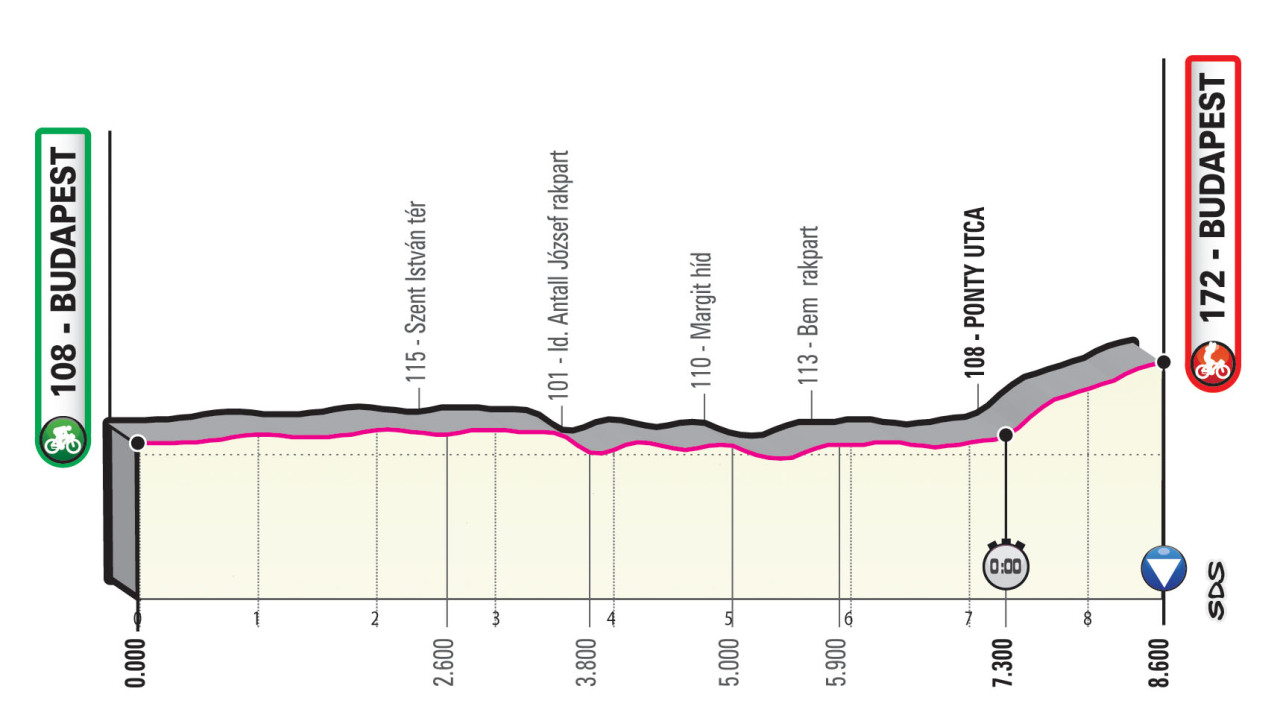
The start is in Hungary with the genesis coming in part from Prime Minister Viktor Orbán’s dentist, a keen cyclist and triathlete. Stage 1 is a prologue on big boulevards and a climb up the Buda castle hill to finish.

Stages 2 and 3 are flat and should be for the sprinters.
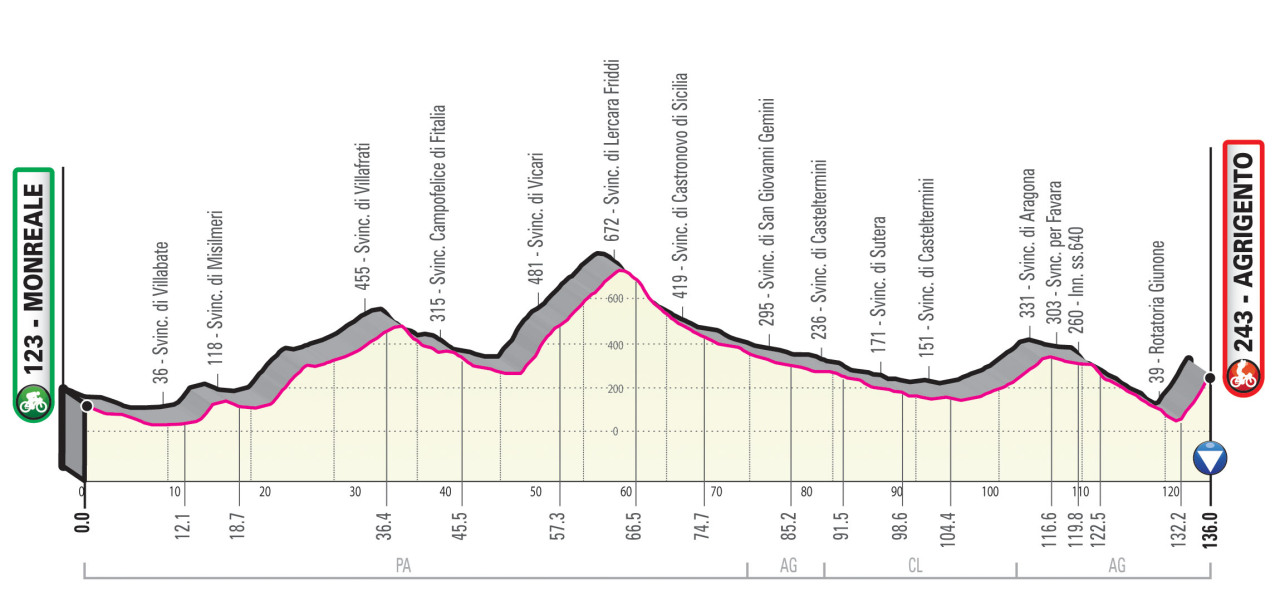
Stage 4 sees the race fly to Sicily with a direct transfer, there’s no rest day in between the grande partenza and the return to Italy so we get a short stage to ease matters. With the final four kilometres in Agrigento rising at 5% it’s an early test for Peter Sagan who has announced he will ride.
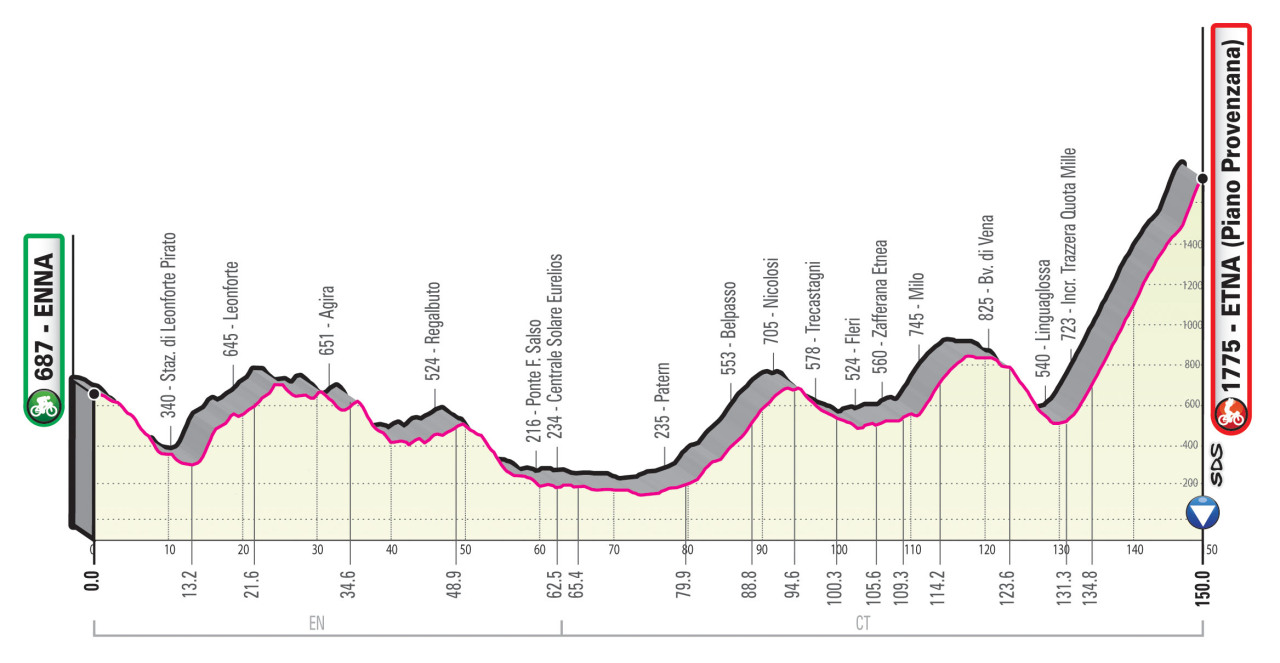
Stage 5 and the first summit finish, on Mount Etna. This is the climb from Lingualossa and then the turning for the Piano Provenzana ski area, of which the final three kilometres are a selective 9%. It’s hard but there was talk of going higher and a gravel section but this sets the theme for 2020, they have scaled things back a bit, and opted for a traditional tarmac finish which for this early in the race is plenty already.

Stage 6 and Vincenzo Nibali’s old training roads via the Portella Mandrazzi, it dominates the profile but it won’t dominate the race, it’s mainly 4-5% on a big road, perhaps a chance for some teams to fatigue rival sprinters but otherwise it’s a short 138km dash.
Stage 7 is a long day in the saddle with undulating roads leading to Monte Scuro and the climb which at 6% goes on for long enough to thin the peloton down before a regular descent to the finish.
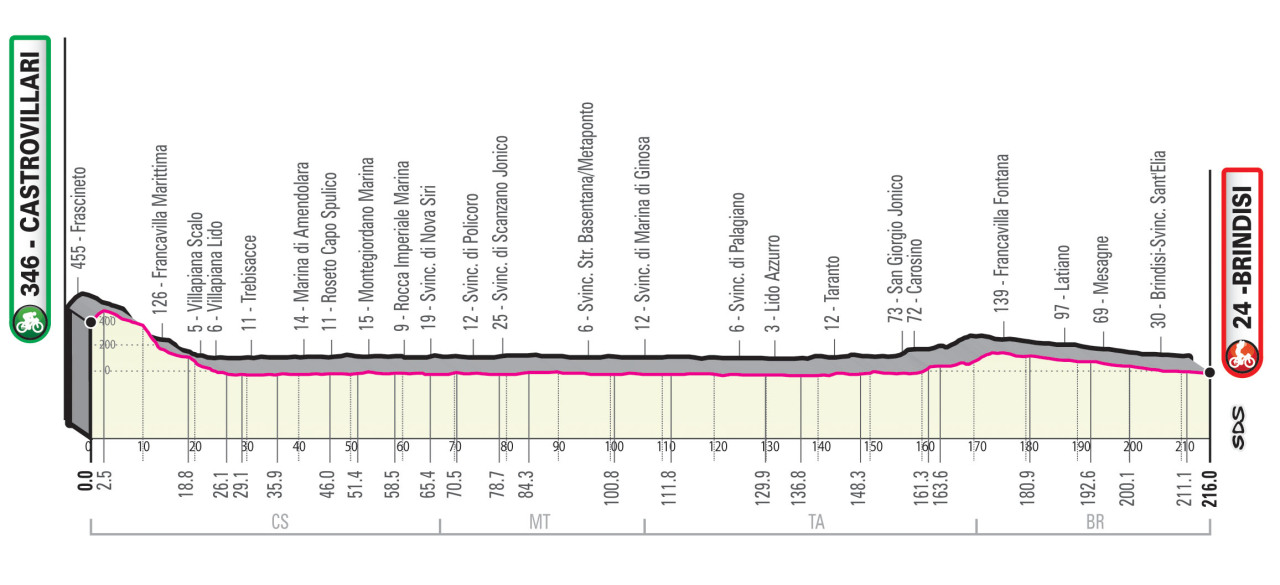
Stage 8 goes up the coast past beach after beach until Brindisi and a likely sprint for this Saturday stage.

Stage 9 looks like another for the sprinters, only that tiny bump on the profile at the end marked Via Saragat is actually a steep wall and should spice up the finish and leave some sprinters behind.

Stage 10 and a route with inevitable comparisons to Milan-Sanremo thanks to the coastal procession followed by a loop into the hills around Tortoreto but it’s a touch harder thanks to the rough roads of the Marche and more climbing in the finish.

Stage 11 and one for the sprinters.

Stage 12 might be more familiar to amateurs than the pros as it borrows from the Nove Colli gran fondo, and it’s a hard day out, a good day for the breakaway but potential ambush country too. With the finish in Cesenatico there’s always a chance to exhume Marco Pantani’s myth once again.
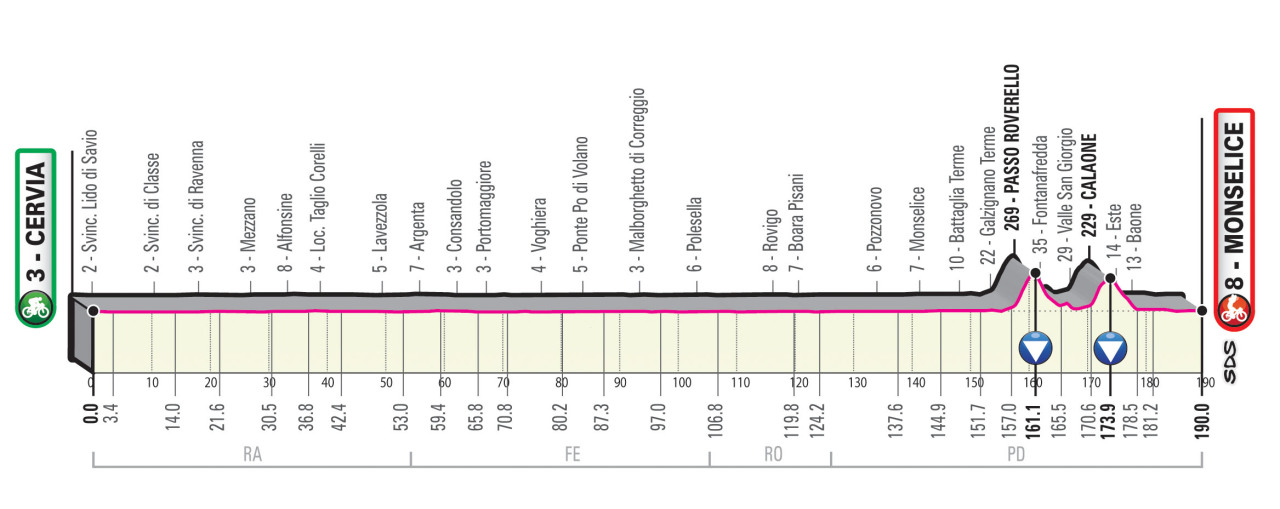
Stage 13 is completely flat – the highest elevation comes from bridges over the autostrada – until they reach the finish and then head out for quick tour of the Colli Euganei with two serious climbs.
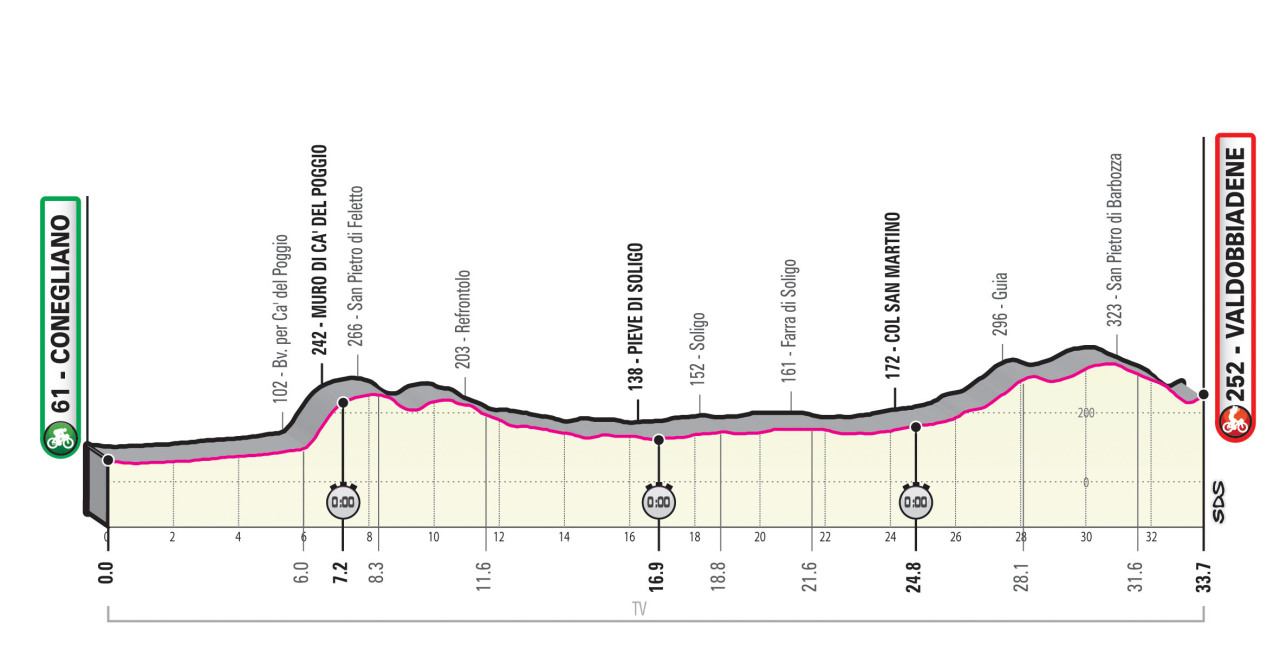
Stage 14 is a 33.7km time trial and the likely “wine stage” as it tours the Prosecco vineyards. Riders will need some fizz for the Ca’ del Poggio, a wall-like climb that has featured in the Giro and other local races too.

Stage 15 and it’s into the mountains with a series of climbs, it’s Alpine but often 6-7% and the hardest part of the Sella Chianzutan is the stone paving and the tunnels. The finish featured in 2017 when Mikel Landa won the stage and Tom Dumoulin lost contact with the main group of contenders on the early slopes but paced himself to limit his losses.
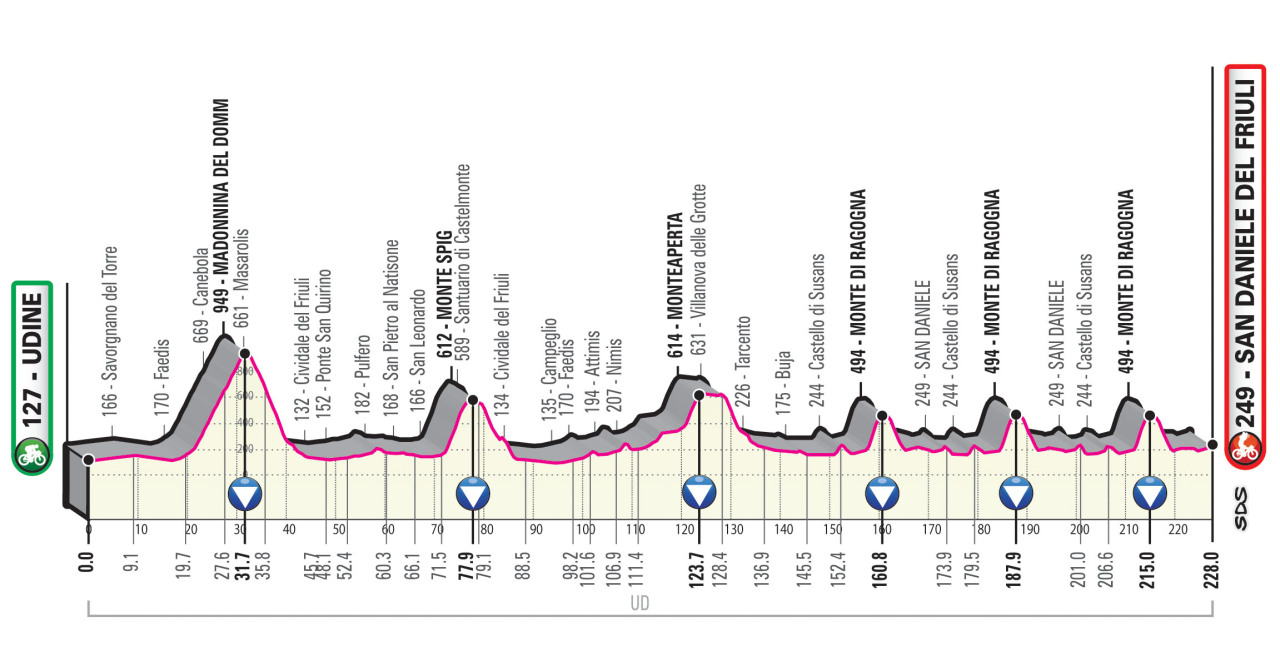
Stage 16 features a finishing circuit with a very tough climb, 3km at 10% and with some parts over 15%, hairpins and all on a narrow woodland road. The descent isn’t so technical but it’s fast and awkward.
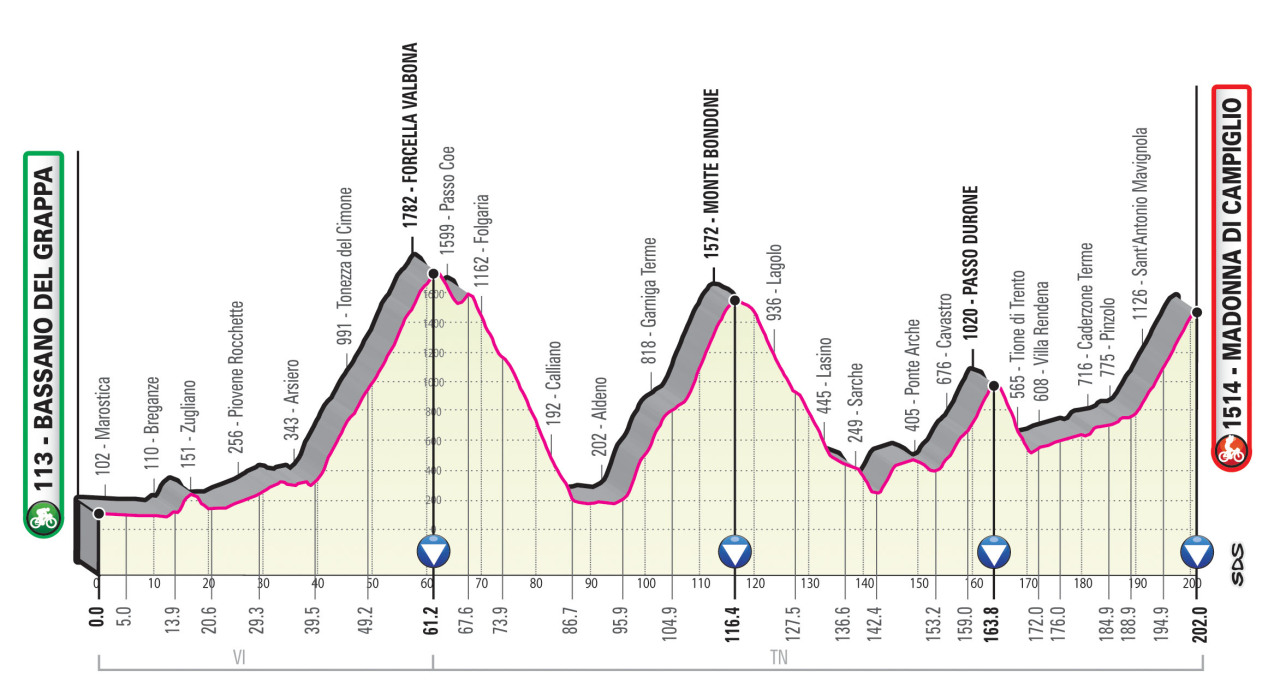
Stage 17 and some classic climbs with Monte Bondone the hardest of the day with some sustained 10% sections and famous for Charly Gaul’s triumph. Madonna di Campiglio is more infamous as the point where Marco Pantani was ejected from the Giro, as for the climb it’s 6.4% for 10km, nothing fierce.
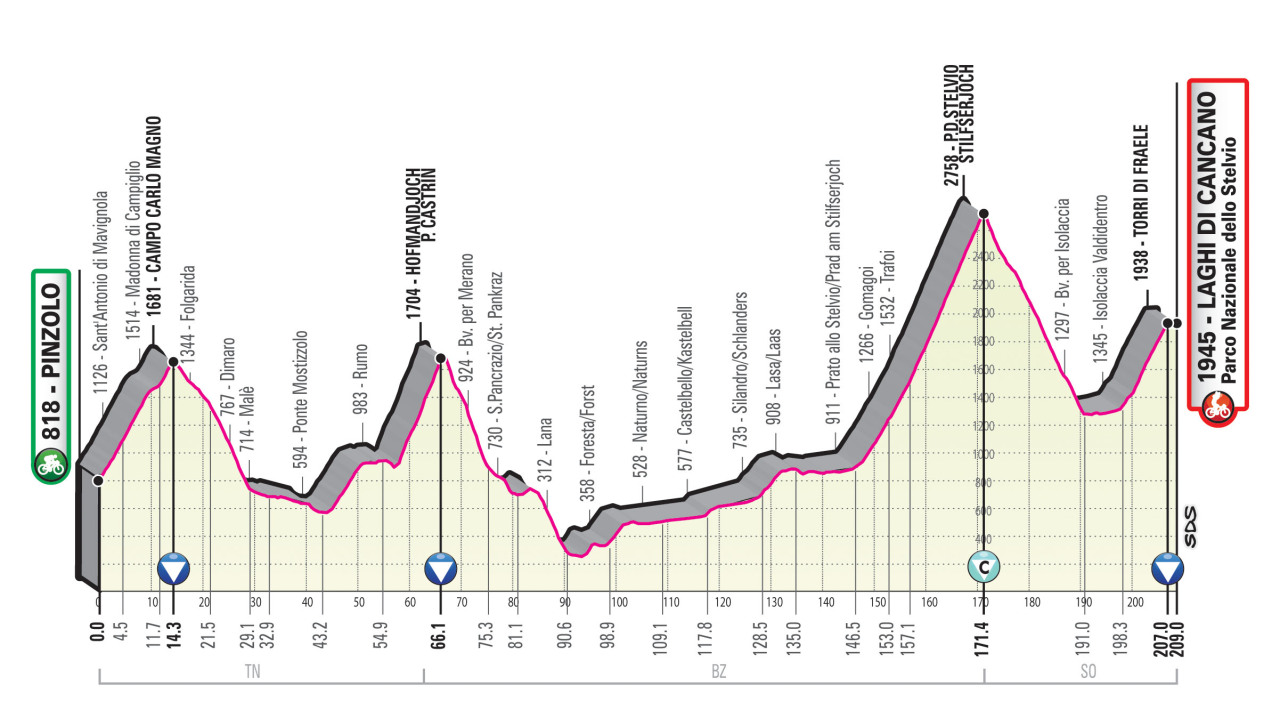
Stage 18 and Pinzolo will be decked out with rollers as riders warm up for the Carlo Magno but it’s the Stelvio that dominates the stage, the high point of the race and climbed via the Trafoi side, the more scenic ascent. The final climb is a turning early on the Foscagno pass to Livigno and the riders sashay up 17 hairpins in tight succession but it’s wide and built so trucks could build and service the giant Cacano dam.
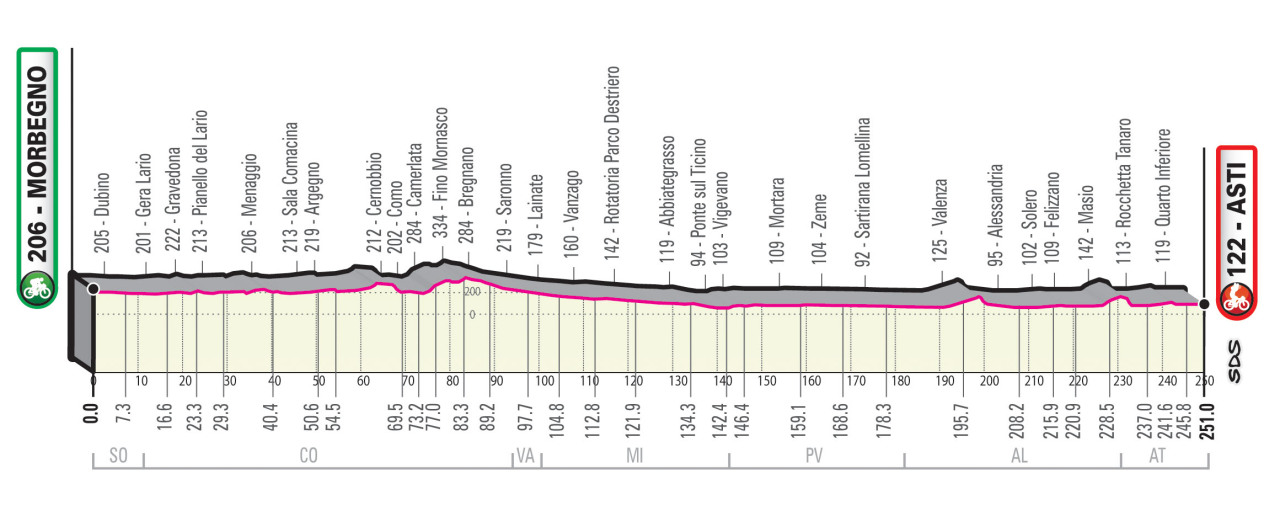
Stage 19 could be part sprint stage, part recovery day to help ensure fresh legs to liven up the next day but it’s a long 251km parade across the Po plains to the foot of the Alps.
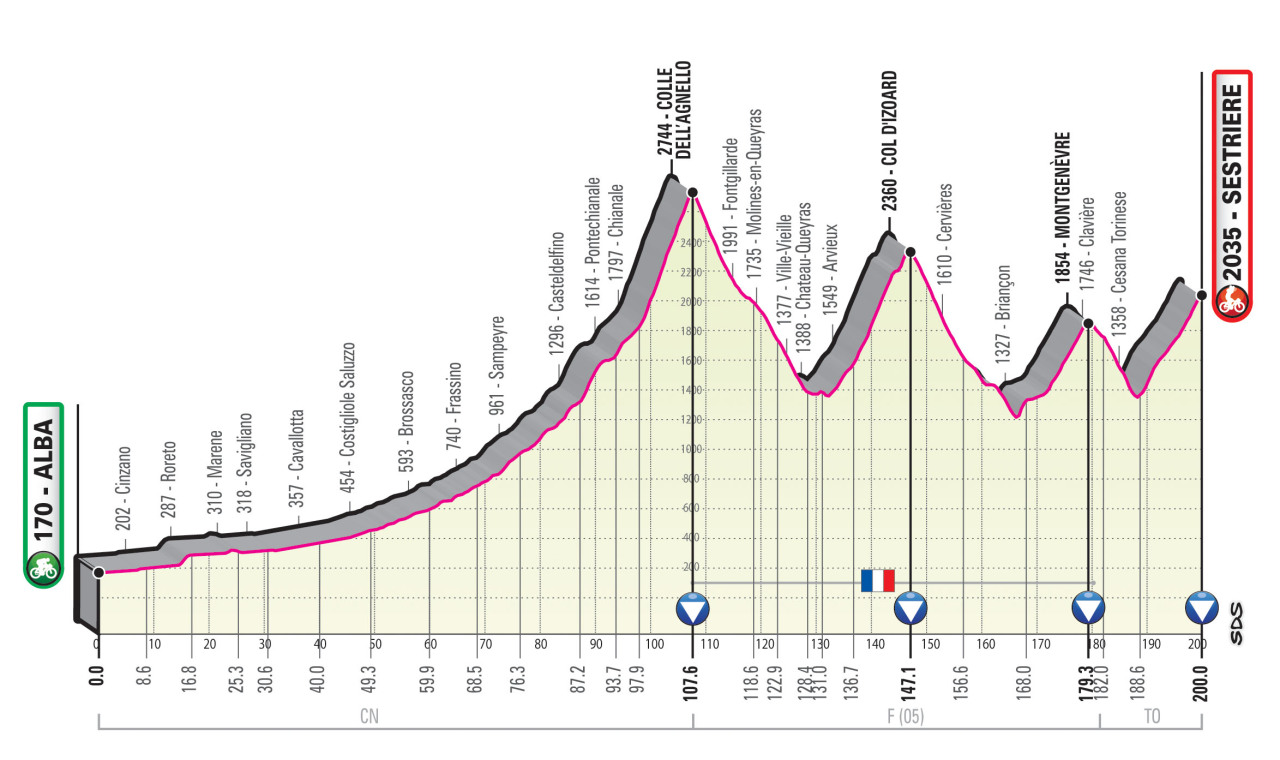
Stage 20 and a huge day in the mountains, an Alpine bonanza featuring some of Europe’s highest passes. First the Agnello where Steven Kruijswijk collided with a snow bank and lost his chances, then it’s into France for Izoard, these are the two hardest climbs of the day. The Col de Montgenèvre was long the main crossing point between France and Italy because of the relatively low altitude and the kind of road trucks used to take. Sestriere is a ski station access road, often 5-6% but by then the hope is that riders are so tired that it’s enough to make the difference.
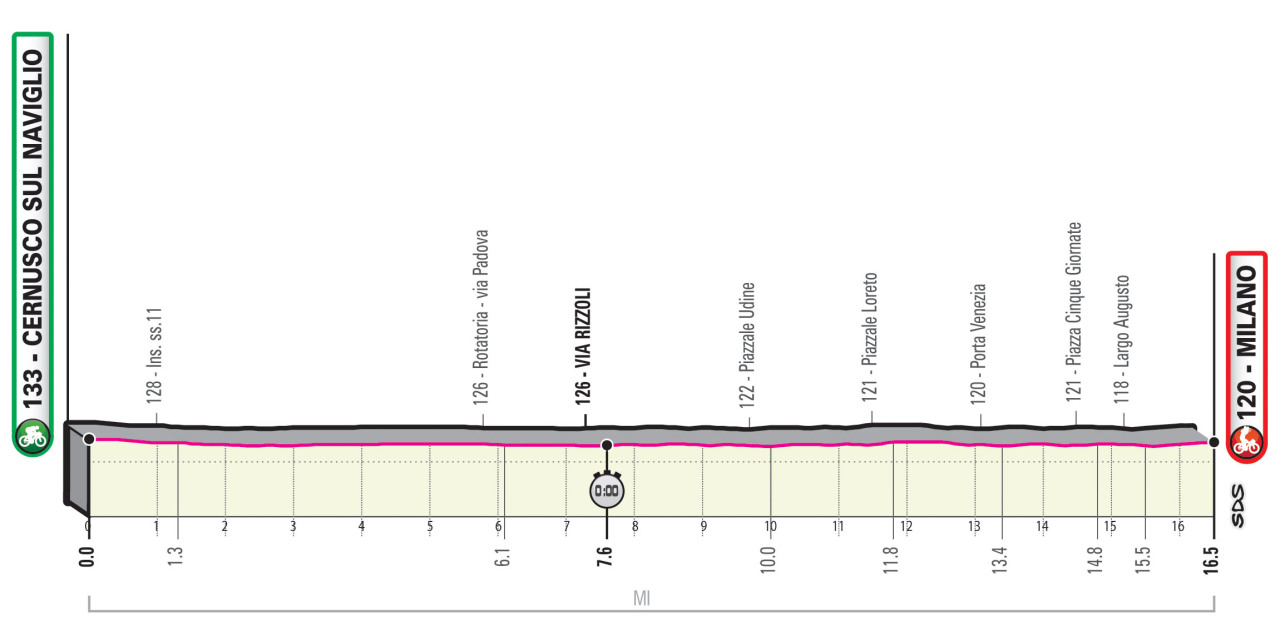
Stage 21 is a 16.5km time trial into Milan and hopefully with two contests, first the stage win for the pure TT specialists who will have hauled themselves over the Alps for this flat course and then the general classification contenders where some can hope to take back 30-45 seconds on rivals.
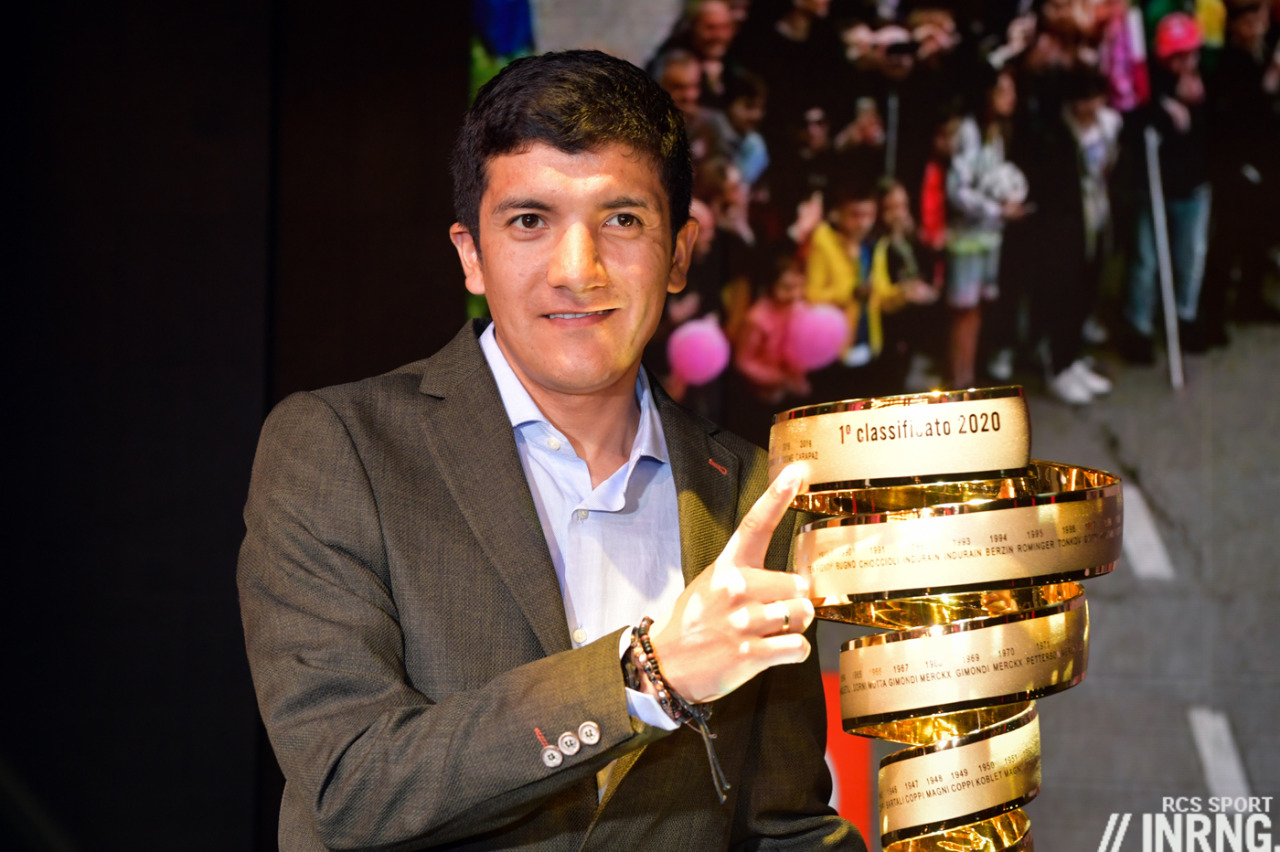
Overall thoughts
A conservative Giro, there’s no gravel, goat paths or gimmicks. Instead this route would not look out of place 15, 20 or 30 years ago, only the time trial distances have shrunk but the other days feature plenty of 200km+ routes including in the mountains and so it’s a bit of a blank canvas, take your pick from any vintage. As ever RCS will have Plan B versions for the high mountains in case of adverse weather but the Giro is a week later than the past and this slot is just when the passes tend to open so it can make all the difference. Once in Sicily it’s got some lively opening stages including an early summit finish in Etna. Stage 12 dips into the Apennines but the Giro doesn’t go big on this mountain range. The Stage 14 TT is significant to the race and then comes the final week in the Alps where Stage 16 could surprise and if not the Agnello, Izoard and Stelvio will pick the winner. Much like the 2019 route the hardest climbs are often mid-stage rather than the summit finish.
Who will win? There’s only so much crystal-ball gazing to be done now, it’s more an exercise in projecting past winter into the start of summer than predicting the winner. We don’t know who is riding yet, for Ineos alone there’s a flowchart of options depending on Chris Froome’s recovery but all the same new recruit Richard Carapaz has a good chance again, ditto Geraint Thomas. Tom Dumoulin’s been out of action for a long time now, if he can recover then does he return to the Giro or have Jumbo hired him for big publicity in July? Vincenzo Nibali is bound to start, he’s turning 35 soon and could shape the race again and has an eye on the Olympics.


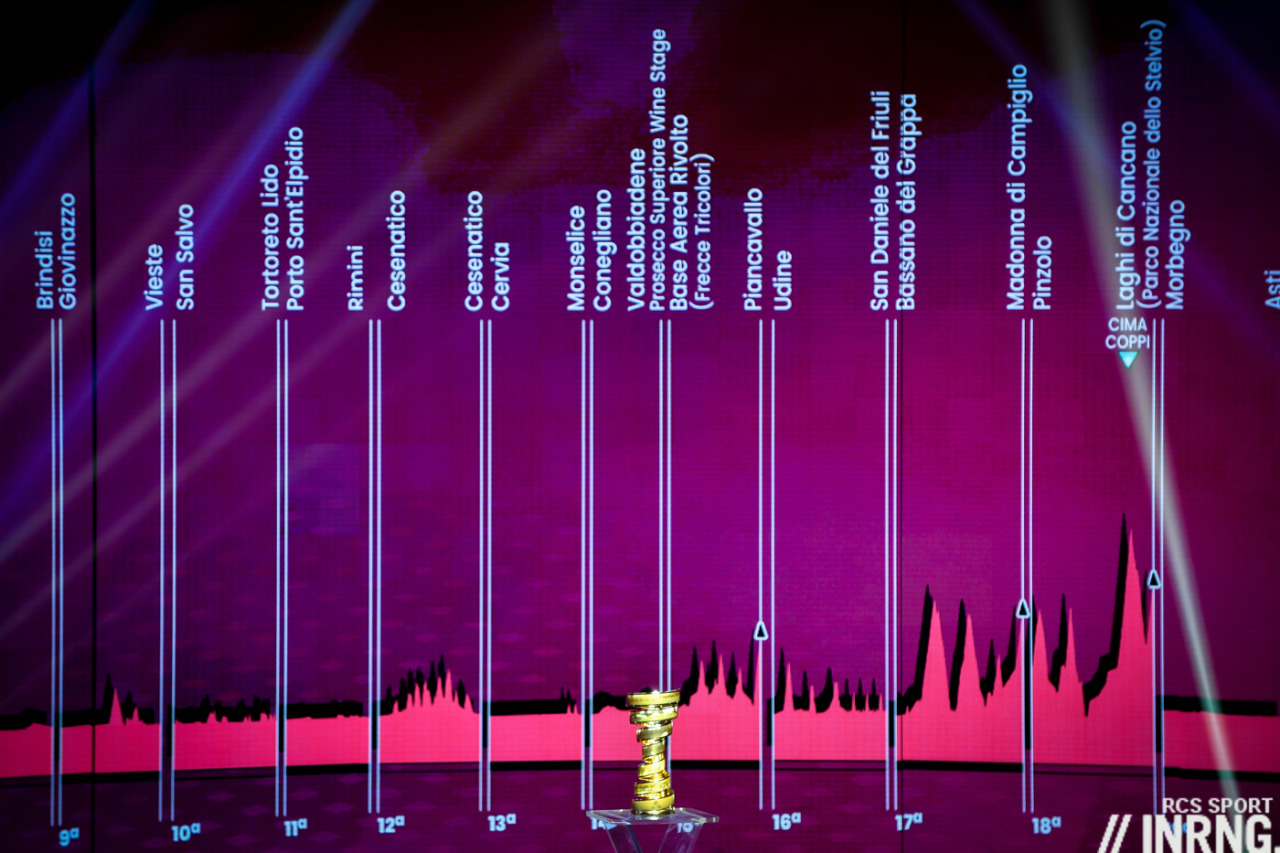
Thanks Inrng. Given that this time last year nobody on this site tipped Mr Carapaz to win, I’m going to be optimistic and say Adam Yates. Failing that, its hard to see beyond six riders from Jumbo / Ineos who have won Grand Tours. Makes sense for Dumoulin to do Giro and let Roglic attack the Tour. I imagine Simon Yates will go full throttle for the Tour, especially given the limited TT kms.
What a disappointing route, after last year sprint fest I was hoping a return to the big mountains and racing almost all days, long are the great routes like the last time Contador won and before.
The giro keeps trying to be the Tour, while the Tour is actually improving lately even with it’s geographic constraints that Italy doesn’t have.
A work for the start in Hungary, another Giro start from a country with dubious (to be really nice) government, after Israel.
Start stages in Hungary will be ignored by me. Like those in Israel. Pure whitewashing of fascist. But when it comes to dubious governments, we would have to ignore a lot of whole Giros.
la grande partenza autocratica! (not sure if that’s really italian…)
2021: Washington, D.C.?
Was in Budapest just on the day the city elected a moderate as its mayor. No need to hold your nose.
Fair amount of cobbles going up to the Var.
Really, what is there to complain about with this route? The final week is intense. The sprint stages are nicely distributed. The TTs will be decisive but don’t get too much weighting, and could leave things poised for a multi-layer battle on the final stage. Old Giro was a week or two of sprints and long TTs before the likes of Supermario would step off just as the mountain stages began.
-And don’t forget: There’s usually some part of the profile which neglects to show some fiendish detail that leaves things wide open for an unexpected attack.
Cue a couple of riders absent from the Big Magyar Start because they were refused a visa.
It would have been good to see Richard Carapaz at this year’s Tour of Britain, so yeah visas can be a problem.
Are you really comparing Hungary with Israel anonymous?
Haha. Fascist? You are just as manipulated as any of Orban’s extrem supporters, just another way around.
The route seems balanced to me in genereal. A bit more traditional one, but thats all good, going back once in a while to the traditions.
The visa problems are with the EU, not country specific within the EU, try to blame Orban on that too:)))
While I understand the reasons why to start a grand tour abroad nowdays – money extra tv views etc, it is also understandable why not to start a grand tour of a country in another.
Though surley thousands of cycling fans are delighted to have a big race to watch closer to their homes.
As an unabashed Sagan fan, I’m not put off by the early stages, though I am disappointed in how pan flat many of them are. Peter isn’t the sprinter he used to be, and needs something to challenge the real fast-men. Regardless, I’ll have plenty to watch as things build towards the mountain showdowns later on. I still don’t have any huge favorites for GC riders, so I enjoy grand tours for what they are: epic athletic soap operas, with multiple story lines, surprises, tragedies, and plenty of drama.
Inring, I don’t recall you writing about the Hungarian start. Is this the work of a wealthy benefactor, or the Hungarian government? I’m pretty sure the Giro gets lots of euros out of it, but I’m not sure what Hungary gets out of it beside a bit of publicity. It did inspire me to see how Hungarian riders have been doing in pro cycling. Last year they jumped 20 places, to 41st on the list of nations according to PCS (take that, China and Iran!). It appears that’s mostly because they had some high finishes in their home race the Tour de Hongrie. Is this the leading edge of the Hungarian wave of cyclists, as we’ve recently seen with Slovenia and Columbia before that?
It’s mainly the government, as touched on above the early work was done by Victor Orban’s dentist, Bátorfi Béla who is behind the Pannon cycling team. As mentioned in a shorts piece last April, Italy and Hungary have a shared history of empire in the past so there are genuine links between the two countries – they could pedal through Austria or Slovenia to reach Italy in a day – and their governments are aligned in some areas too; less so today following Salvini’s walk into the wilderness but Orban recently gave Salvini an epowers bike, a Hungarian brand.
I don’t think we’ll see a wave of Hungarian elite cyclists off the back of this, it takes more time but Attila Valter (yes, Attila the Hungarian) is one to watch, he’s signed with CCC.
Barnabás Peák (b. 1998 like Attilá Valter) is another Hungarian rider to watch: https://www.segracing.com/barnabas-peak-set-to-join-mitchelton-scott/
A Hungarian Grande Partenza is just a step, albeit admittedly a big one, in Béla Bátorfi’s plans. He fully expects his Pannon Cycling Team to ride at the top level in a not unrealistically short time frame. Before that he wants to establish a cycling academy, a boarding school type system for young riders from 16-year-olds upwards, not only for Hungarian cyclists but for the entire region.
He has proudly posed in photographs with Alberto Contador (whose Kometa team participated in Tour de Hongrie and had Márton Dina (b.1996) in its roster) and expressed his wish that the two would co-operate in this project.
Since you brought politics into this I think the current Italian GOVERNMENT is very much NON-aligned with Orban’s regime in Hungary.
OTOH RCS doesn’t seem to give a rat’s a– where the money comes from..autocratic, right-wing regimes seem just fine to them as they tend to be on that side of the political spectrum themselves. Wouldn’t surprise me at all if a Russian oligarch put up enough rubles to get a “Big Start” in Moscow sometime in the future 🙁
Thanks for the additional info. Cycling is so full of these wacky, strange, intriguing connections, and your willingness and ability to highlight them and put them in a modern context is why I keep coming back here.
For me it would be very interesting to see some more top level races in central Europe. I’ve visited the region a few times before and somehow I’m inclined to think there are a lot of beautiful and exciting races to be had in nice scenery and over mystical mountains. There’s a lot of history as well. Also, there’s actually quite a few cycling stars coming from Central European countries, like Sagan, Kwiat, Majka, Stybar. It would be great if there would be ever be a WT level ‘Visegrad Tour’. And the Tour of Poland getting better line-up and more TV time.
Nice route for a challenge between Moser and Saronni, but may also end with an Hampsten surprise.
Nice one, asram, but no sub-zero Stelvio passage …
The route does not intrigue, however, the team politics will likely be more interesting. As mentioned above, Dumoulin with Roglic both on J-V Team trying to decide which one will opt-out of the Tour by taking on the Giro, and Bernal “sitting-up” and waiting for Froome by saying he might be interested in riding the Giro next year, which means he’ll be pulling for Froome in the Tour. Already, the brew is mixing!
I might be reading the profile wrong, but isn’t the opening stage just a little too long to be a prologue?
Quite right you are, about 600 m too long:
“2.6.006 A prologue may be included in stage races on condition that:
1. it must not exceed 8 km; …”
The article has no apparent exceptions, but – as always – you canapply for an excemption with the UCI. I suppose RCS did so.
I guess you missed CONEGLIANO > VALDOBBIADENE (Prosecco Superiore Wine Stage) regarding Stage 14? It’s clearly noted on the Giro website that went up when the route was announced.
Other than the obvious Hungarian money-grab by RCS I like the route, especially the race up the Stelvio in the classic direction and the tappone that finishes in Sestriere.
Ok, noted the “wine stage” is a formal thing again. Generally it helps to avoid race websites for previews like this above or the daily ones as you risk being dependent on the one version they want to tell you rather than cross-checking different sources about a climb, descent, road etc.
Ooops! That was me above, sorry.
It’s ok Larry. The rANdom CapITALIsaTIon made it ObviOuS.
This seems much more of the GT route than the 2020 Tour, high mountains, sprint stages, a prologue, a (shortish) TT and plenty of possible Giro “ambush” stages in southern and central Italy. Gimmicks are all well and good but there seems little reason to endlessly fiddle around with a formula that works well. There is plenty of challenge here for the riders and, after all, it is they not the course designers who make the race. Bit surprised they went for the Stelvio rather than the Gavia after that stage had to be rerouted this year (chances of similar snow conditions are pretty small). I also think the race is better when they traverse the alps east to west, the mountains in the west of the Italian alps (and over the border in France) offer more spectacular final stages.
It will be interesting to see which riders go for the Giro over the Tour, plenty to keep the cycling media occupied with months of rumour and speculation!
Not a bad route, nothing overly exciting but at least not the sprint (snooze) fest of this year. Looking forward to the “big starts” in Venezuela or perhaps North Korea in the coming years!
With almost 59km of time trialling, Tom Dumoulin and Primoz Roglic might be fighting each other to ride in Italy given that there’s only 36km of TT in the Tour!
If Sagan is doing both the Giro and the Tour, how long will his travels in Italy last?
Two weeks?
It seems most unlikely that he’ll want to give up on a Green Jersey in France, or is it possible to chase both points jerseys?
I can’t imagine that the maglia ciclamino means all that much to him. I think if he’s have won a points jersey in the Vuelta he would be more likely to go for all three, but to slog through that brutal last week, just for a shot at the final sprint stage and yet another points jersey won’t be too attractive after what’s likely a very full spring campaign.
Good point! Rumors are there’s appearance money on offer, like for Froome a couple of years ago. But what I find interesting in all the hoopla about Sagan at the Giro is that HE never said on the TV show that he was going. Lot’s of “we’ll see” and half smiles while the TV presenters sort of assumed it was a done deal. Lots of published stories and quotes saying he’ll be there, but I’ve yet to see video or hear audio of Sagan himself saying anything close to “See you in Hungary in May”. Did I miss it somehow?
Maybe waiting for the check to clear?
“I’m delighted to announce that on May 9th, I will be on the starting line in Budapest, ready to tackle this iconic Grand Tour for the first time.”
I guess that sounds pretty clear. He said it during the route presentation in Milan.
Btw. all three “hungarian” stages take place close to the slovak-hungarian border so there is another motivation for Peter to deliver the win for big slovak crowds there.
Yes and the team have confirmed this too and say he’ll ride the Tour as well.
Really? I watched the entire thing along with my wife (who is fluent in the language) and somehow neither one of us heard that come out of Sagan’s mouth. We both kept waiting for it, but we never heard it, despite the smiles and talk from pretty much everyone else how happy they’d be to see him there. Pretty much the same with Carapaz. All we heard from both was vague stuff about how their 2020 programs won’t be set until January and “we’ll see” in response to the constant (almost nagging) from the Italians on the stage.
Really? I watched the entire thing along with my wife just to see if he would say such a thing, but somehow we both missed it? Do you have a link to an audio or video (and perhaps where it comes up in the clip?) so I can see for myself? I’m really puzzled about this.
Milan-San Remo, the cobbled classics, then the Giro, then the Tour, and a crack at the Olympics to boot? Seems like a tall order.
I assume if he takes part in the Giro, he won’t be there in the Tour. Bora has no shortage of quality sprinters though, and the multiple punchy stages on the Tour could suit a rider like Schachmann.
He’s already ruled out the Olympics, and said he’s going to the Tour.
stage 7 – Monte Scuro frm Cozensa, a very uneven climb on rough roads that ends on the Sila Platau whith the clearest sky and cleanest air anywhere in the EU. (Its psoible to continue to Botte Donato at almost 2000m).
Climbed Monte Scuro from Cozensa and continued up to Donato, continued to San Giovani in Fiore via Camigliatello Silano in 2016 on a creditcard tour from Bologna to Reggio Calabria in 2016.
Sila (and Cozensa) is one of the forgotten gems of southern Italy. Woth a vissit for hiking and bikeing.
update. Monte Scuro is 1400m of elevation, that is more then the climbs on Scicliy incl the Etna stage (and a lot more than ex Alpe d’Huez).
This stage will create significant gaps compared to Scicly, despite the (pretty) descent.
Whilst it looks like there’ll be a few snooze days I think it looks like a decent GC battle course, although one for the TTers, but aren’t most grand tours these days?
I think Roglic will go to the Tour – he’s the form GC rider at the moment and I think this is his big chance. Reckon both Yates, Pinot, Bardet, Landa will all go to the Tour too as it is TT light. So Giro between Carapaz, Thomas, perhaps Dumoulin, Kruiswijk, Nibali.
I think this course suits Thomas quite well. He’ll probably take time on all but Dumoulin in the TTs, and there are quite a few summit finishes where he may be able to grab a dozen seconds plus some bonus time with a 2km to go attack. If Ineos can muster a team to control those stages.
If they start in Hungary, why not ride through Slovenia back to Italy. Seems simpler, and I’m sure you’d find Slovenian cities willing to host, with all the Roglic and Pogacar craze.
That’s for next year. Obviously.
Oh please, NO! Giro d’ITALIA is the name. Bad enough they start the thing elsewhere just for the fees they get, but at least (for now) they get back to Italy ASAP after the loot has been collected and obligations fulfilled.
I wonder if Sagan and his people knew that the Tour of California wasn’t going to be held in 2020 before the committed to the Giro? Regardless, this is very sad news. How can a country as wealthy as the US, and with so many millions of people who enjoy cycling, have such a small footprint within the sport?
That’s a rhetorical question, by the way. I can think of plenty of reasons, but it’s still unfortunate.
Someone will write the history of ToC now that it’s dead but I recall the organizers having some sort of a “start-up” type plan. They would develop this event, then sell it to some rubes with more dollars than sense. But no rubes turned up so they kept at it, burning through money (Amgen’s?) in the hopes some rubes would eventually turn up. My guess is selling it to ASO was their last, best hope but either ASO didn’t want it (or didn’t want to pay enough) so they’re not throwing any more money away on it.
IMHO it’s not a big loss as I pretty much ignored it as a “California Vacation” for those basing their seasons around TdF.
You’re right not to have any sympathy for AEG, but this is a loss to the sport worldwide and especially to N America, where you would think UCI should have major ambitions.
– Is there any indication this decision was brought on by the supposed UCI reforms not happening in a way that AEG thought they might?
When it was in the winter I put it in the category of Tour Down Under…something to do before things got serious and a nice treat for local fans. But when they put it up against my beloved Giro d’Italia it was hubris and they deserved to fail.
Nobody with any money really gives a s–t about cycling in the USA and probably never will. Some things just have their place/home, like perhaps cricket or NFL? No matter what JV and Velon does, that’s not gonna change.
I don’t think it was a bad idea to put it against the Giro – it made it a decent race for GC racers/climbers/sprinters who were planning on racing the TdF and not the Giro to stay fresh. Making it a WT race was probably a bad idea, though.
I agree, I don’t mind these new races at either ends of the seasons, particularly at the start. They serve basically as pre-season friendlies, and they probably shouldn’t be ‘World Tour’ if that label is to mean anything. But don’t mess with the meat and drink of the season which is and always should be Opening Weekend – Strade Bianche – ParisNice/TirrenoAdriatico -Spring Classics – Giro – Dauphine/Nationals/Suisse – Tour – San Sebastian – Vuelta – Worlds – Italian Classics/ParisTours.
Sagan gets appearance fees for a lot of races. They would have known for sure as a result of not having an agreement in place that TOC was on shaky ground. They would’ve also known the Giro could arrange for some big money for him after Froome. Pretty sure Sagan’s team got the deal done in time and RCS are kicking themselves now.